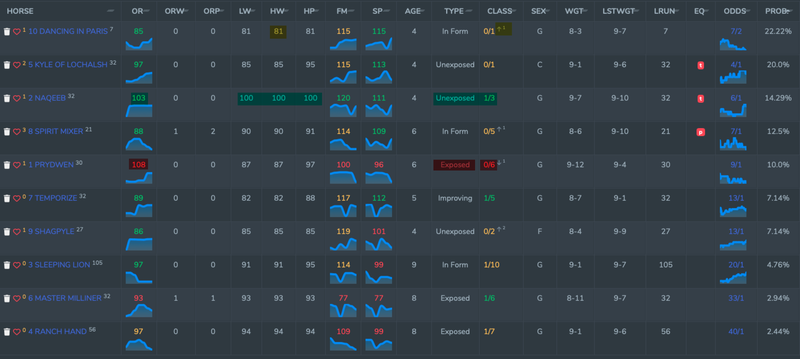Using Handicap Ratings, Horse Type and Horse Race Class To Find Winners

In handicap races, horses are assigned different weights to carry during the race. This system is designed to equalize the chances of winning for all participants, regardless of their past performance. The objective is to give each horse an equal opportunity to compete, thus making the race more open and unpredictable.
The weights are assigned by official handicappers who assess each horse’s performance history. Horses that have performed well in previous races carry more weight, while those with less impressive records carry less. The weight assigned to a horse is intended to counterbalance its previous successes, theoretically bringing all horses to an equal level of competitiveness.
This article provides data and insights using the popular BetTurtle horse racing website to help narrow down the potential winners in handicap races.
BetTurtle Handicap Race Data
BetTurtle provides some unique data that can help determine the likely winners in a handicap race.

Horse Type (Type)
Unexposed - A horse that has only raced a few times and is potentially open to considerable improvement, as it ages, gains experience or races under different conditions.
Improving - A horse that is improving and climbing the handicap ratings. Can be worth following until the improvement stops.
In Form - A horse that has been running well perhaps winning or coming close.
Exposed - A horse whose preferences are well understood. May win occasionally, but may struggle against unexposed or improving horses.
Sleeper - A horse that has not been running well, but has been dropping down the handicap ratings. Could return to form at big prices.
Well Handicapped (OR)
Green - Horse is well handicapped
Amber - Handicapped correctly or potential to be well handicapped.
Red - Poor handicapped.
Class Change (Class)
Up - Upped in class and this likely to be a more competitive race
Same - Running against a similar level of competition
Down - Running in a less competitive race
Handicap Statistics
Using data from the previous 3 years, we can see below how the previously described data can be used to provide a betting edge.

Improving, unexposed and in-form horses with green or amber well handicapped ratings have a distinct edge over other runners.
Although, sleeper types down in class should be considered too.
How To Use These Insights
All horses types, no matter the class or how well handicapped they are, can have winners. However, the strike rates show that certain combinations win a lot more often than others.
Therefore, when considering betting on a horse, use the table above plus other factors to determine whether a horse is good value in terms of odds before placing a bet.
For example, a short priced exposed horse, who is deemed poorly handicapped, is well worth taking on in a race.
A Practical Example
To help bring this to life, here is an example of how a race could be analysed using these insights.

First of all let's consider the race favourite, Dancing In Paris.
The horse is in form and has won 2 from his last 3 runs. As a result has climbed up the handicap ratings and is now upped in class. This is a much tougher race and the horse will need to improve, so at odds of 7/2 is worth taking on.
The exposed top weight, Pryden, is deemed poorly handicapped and has never won in 6 attempts in this class of race and is worth ignoring for betting purposes.
Likewise, Spirit Mixer is up in class and is 0 from 5 at this level and can also be discounted.
Kyle Of Localsh has been improving, but is now 12lbs higher than highest winning mark which is a concern at 4/1.
Therefore, the unexposed Naqeeb looks the horse that represents the best value in the race, as he has won in the class, has also won off of a mark close to today's handicap rating and could improve further.
Higher priced horses, such as Temporize and Sleeping Lion may also be worthy of each way consideration.





